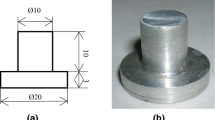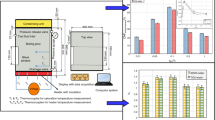Abstract
In this investigation, an experimental study was conducted using different nanofluids to analyze nucleate pool boiling at saturated conditions. An experimental setup was developed to investigate the effect of heating surface characteristics and nanofluids on the heat transfer coefficient. Pool boiling tests were performed using deionized water as well as the Fe2O3-water and Al2O3-water nanofluids. Two copper heating surfaces, smooth and rough, were used in this investigation. By examining experimental data and surface characteristics before and after pool boiling, researchers investigated the effect of surface/nanofluid interaction and the impact of nanoparticle deposition on the heating surface. The present work investigates the impact of surface roughness and nanoparticle deposition on heat transfer during nucleate pool boiling using different nanofluids. The experimental data and surface characteristics before and after boiling were examined to evaluate the effect of surface/nanofluid interaction on heat transfer. This investigation examined how surface roughness and nanoparticle deposition impact heat transfer during boiling. It is found that the rough surface increased HTC by 48% compared to the smooth surface. Al2O3-water and Fe2O3-water nanofluids increased HTC by 52% and 62%, respectively, for low-concentration nanofluids on the smooth surface. The alumina nanofluid had a slight increase of 15% in HTC up to 400 W(m2K)−1, while the maghemite nanofluid had an HTC lower than water. For the rough surface and low-concentration nanofluids tested, HTC increased by 21% for alumina and 9% for maghemite up to 300 W(m2K)−1, followed by a decrease for higher heat fluxes. It is concluded that rough surfaces with active nucleation sites have a significant impact on HTC during boiling. Images showed that the rough surface had more steam bubbles compared to the smooth surface, indicating more active nucleation sites.
















Similar content being viewed by others
Abbreviations
- C sf :
-
Fluid surface coefficient (–)
- c p :
-
Heat specific to constant pressure (Jkg−1·K]
- RS:
-
Rough surface
- SS:
-
Smooth surface
- LC:
-
Low concentration
- HC:
-
High concentration
- dp:
-
Average nanoparticle diameter (m)
- g :
-
Acceleration of gravity (ms−2)
- h :
-
Heat transfer coefficient (Wm−2 K)
- h lv :
-
Latent heat of vaporization (Jkg−1)
- k :
-
Thermal conductivity (Wm−1·K)
- k b :
-
Thermal conductivity of the base fluid (Wm−1·K)
- k c :
-
Thermal conductivity of copper (Wm−1·K)
- k nf :
-
Thermal conductivity of nanofluid (Wm−1·K)
- k p :
-
Thermal conductivity of the nanoparticle (Wm−1·K)
- L :
-
Distance between thermocouples (m)
- Pr:
-
Prandtl number
- q″ :
-
Heat flow (Wm−2)
- q′ :
-
Average heat flux measured (Wm−2)
- R :
-
Electrical resistance (Q)
- r :
-
Roughness factor (–)
- R c :
-
Cavity radius (m)
- R nd :
-
Rugosidade adimensional (–), definido pela Eq. (19)
- T sat :
-
Temperatura de saturacao do fluido (K)
- T p :
-
Surface temperature (K)
- u :
-
Experimental uncertainty
- vol%:
-
% By volume of nanoparticles in the base fluid (–)
References
Akbari A, Alavi Fazel SA, Maghsoodi S, Kootenaei AS. Pool boiling heat transfer characteristics of graphene-based aqueous nanofluids. J Therm Anal Calorim. 2019;135(1):697–711. https://doi.org/10.1007/S10973-018-7182-2.
Ali HM, Generous MM, Ahmad F, Irfan M. Experimental investigation of nucleate pool boiling heat transfer enhancement of TiO2-water based nanofluids. Appl Therm Eng. 2017;113:1146–51. https://doi.org/10.1016/j.applthermaleng.2016.11.127.
Alimoradi H, Shams M, Ashgriz N. Enhancement in the pool boiling heat transfer of copper surface by applying electrophoretic deposited graphene oxide coatings. Int J Multiph Flow. 2023. https://doi.org/10.1016/j.ijmultiphaseflow.2022.104350.
Dadjoo M, Etesami N, Esfahany MN. Influence of orientation and roughness of heater surface on critical heat flux and pool boiling heat transfer coefficient of nanofluid. Appl Therm Eng. 2017;124:353–61. https://doi.org/10.1016/J.APPLTHERMALENG.2017.06.025.
Dang C, Ding Y, Qi Z, Yin L, Jia L. Experimental investigation of saturated nucleate pool boiling heat transfer characteristics of R245fa on a copper foam covered surface. Int J Heat Mass Transf. 2021. https://doi.org/10.1016/j.ijheatmasstransfer.2021.121740.
Das S, Johnsan R, Sujith Kumar CS, Datta A. Experimental study of pool boiling heat transfer on an annealed TiO2 nanofilm heating surface. J Therm Anal Calorim. 2021;144(3):1073–82. https://doi.org/10.1007/S10973-020-09503-3.
Etedali S, Afrand M, Abdollahi A. Effect of different surfactants on the pool boiling heat transfer of SiO2/deionized water nanofluid on a copper surface. Int J Therm Sci. 2019. https://doi.org/10.1016/j.ijthermalsci.2019.105977.
Gajghate SS, Barathula S, Das S, Saha BB, Bhaumik S. Experimental investigation and optimization of pool boiling heat transfer enhancement over graphene-coated copper surface. J Therm Anal Calorim. 2020;140(3):1393–411. https://doi.org/10.1007/S10973-019-08740-5.
Ham J, Kim H, Shin Y, Cho H. Experimental investigation of pool boiling characteristics in Al2O3 nanofluid according to surface roughness and concentration. Int J Therm Sci. 2017;114:86–97. https://doi.org/10.1016/J.IJTHERMALSCI.2016.12.009.
Kangude P, Srivastava A. Performance of SiO2-water nanofluids for single bubble-based nucleate pool boiling heat transfer. Int J Therm Sci. 2019;138:612–25. https://doi.org/10.1016/j.ijthermalsci.2019.01.027.
Karthikeyan A, Coulombe S, Kietzig AM. Boiling heat transfer enhancement with stable nanofluids and laser textured copper surfaces. Int J Heat Mass Transf. 2018;126:287–96. https://doi.org/10.1016/J.IJHEATMASSTRANSFER.2018.05.118.
Khalaf-Allah RA, Eid EI, Al-Nagdy AA. Nucleate pool boiling enhancement with the application of a hybrid technique involving the addition of alumina nanoparticles to stirred water above heating surface. Int J Therm Sci. 2021. https://doi.org/10.1016/j.ijthermalsci.2021.107134.
Ma X, Song Y, Wang Y, Zhang Y, Xu J, Yao S, Vafai K. Experimental study of boiling heat transfer for a novel type of GNP-Fe3O4 hybrid nanofluids blended with different nanoparticles. Powder Technol. 2022;396:92–112. https://doi.org/10.1016/J.POWTEC.2021.10.029.
Manetti LL, Stephen MT, Beck PA, Cardoso EM. Evaluation of the heat transfer enhancement during pool boiling using low concentrations of Al2O3-water based nanofluid. Exp Thermal Fluid Sci. 2017;87:191–200. https://doi.org/10.1016/J.EXPTHERMFLUSCI.2017.04.018.
Moghadasi H, Saffari H. Experimental study of nucleate pool boiling heat transfer improvement utilizing micro/nanoparticles porous coating on copper surfaces. Int J Mech Sci. 2021. https://doi.org/10.1016/j.ijmecsci.2021.106270.
Moghadasi H, Malekian N, Aminian E, Saffari H. Thermodynamic analysis of entropy generation due to energy transfer through circular surfaces under pool boiling condition. J Therm Anal Calorim. 2022;147(3):2495–508. https://doi.org/10.1007/S10973-021-10561-4.
Nazari A, Saedodin S. An experimental study of the nanofluid pool boiling on the aluminium surface. J Therm Anal Calorim. 2019;135(3):1753–62. https://doi.org/10.1007/S10973-018-7609-9.
Norouzipour A, Abdollahi A, Afrand M. Experimental study of the optimum size of silica nanoparticles on the pool boiling heat transfer coefficient of silicon oxide/deionized water nanofluid. Powder Technol. 2019;345:728–38. https://doi.org/10.1016/J.POWTEC.2019.01.034.
Quan X, Wang D, Cheng P. An experimental investigation on wettability effects of nanoparticles in pool boiling of a nanofluid. Int J Heat Mass Transf. 2017;108:32–40. https://doi.org/10.1016/J.IJHEATMASSTRANSFER.2016.11.098.
Rashidi S, Hormozi F, Sarafraz MM. Fundamental and subphenomena of boiling heat transfer. J Therm Anal Calorim. 2021;143(3):1815–32. https://doi.org/10.1007/S10973-020-09468-3.
Saffari H, Fathalizadeh H, Moghadasi H, Alipour S, Hosseinalipour SM. Experimental study of pool boiling enhancement for surface structuring with inclined intersected mesochannels using WEDM method on copper surfaces. J Therm Anal Calorim. 2020;139(3):1849–61. https://doi.org/10.1007/S10973-019-08601-1.
Salehi H, Hormozi F. Prediction of Al2O3–water nanofluids pool boiling heat transfer coefficient at low heat fluxes by using response surface methodology. J Therm Anal Calorim. 2019;137(3):1069–82. https://doi.org/10.1007/S10973-018-07993-W.
Sarafraz MM, Hormozi F. Pool boiling heat transfer to dilute copper oxide aqueous nanofluids. Int J Therm Sci. 2015;90:224–37. https://doi.org/10.1016/j.ijthermalsci.2014.12.014.
Sharma PO, Unune DR. Augmentation of pool boiling performance using Ag/ZnO hybrid nanofluid over EDM assisted robust heater surface modification. Coll Surf A Physicochem Eng Asp. 2022. https://doi.org/10.1016/j.colsurfa.2022.130150.
Sonawane SS, Thakur P, Bhaisare S, Jadhav P. Experimental investigations of the nanofluid applications in the pool boiling process. Appl Nanofluids Chem Bio-Med Process Ind. 2022. https://doi.org/10.1016/B978-0-323-90564-0.00003-9.
Wen T, Luo J, Jia K, Lu L. Pool boiling heat transfer enhancement of aqueous solution with quaternary ammonium cationic surfactants on copper surface. Int J Heat Mass Transf. 2022. https://doi.org/10.1016/J.IJHEATMASSTRANSFER.2022.122761.
Wen T, Luo J, Jiao K, Lu L. Experimental study on the pool boiling performance of a highly self-dispersion TiO2 nanofluid on copper surface. Int J Therm Sci. 2023. https://doi.org/10.1016/j.ijthermalsci.2022.107999.
Xing M, Yu J, Wang R. Effects of surface modification on the pool boiling heat transfer of MWNTs/water nanofluids. Int J Heat Mass Transf. 2016;103:914–9. https://doi.org/10.1016/J.IJHEATMASSTRANSFER.2016.07.053.
Yagnem AR, Venkatachalapathy S. Heat transfer enhancement studies in pool boiling using hybrid nanofluids. Thermochim Acta. 2019;672:93–100. https://doi.org/10.1016/J.TCA.2018.11.014.
Zhong Z, Huang C, Wang X. Enhanced pool boiling heat transfer of multilayer copper-nanoparticle-packed beds by copper mesh coating. Int J Therm Sci. 2023. https://doi.org/10.1016/j.ijthermalsci.2022.107965.
Choi SUS, Eastman JA. Enhancing thermal conductivity of fluids with nanoparticles. United States; 1995. https://www.osti.gov/servlets/purl/196525.
Rohsenow WM. A method of correlating heat transfer data for surface boiling of liquids. Trans ASME. 1952;74:969–76.
Author information
Authors and Affiliations
Corresponding author
Additional information
Publisher's Note
Springer Nature remains neutral with regard to jurisdictional claims in published maps and institutional affiliations.
Rights and permissions
Springer Nature or its licensor (e.g. a society or other partner) holds exclusive rights to this article under a publishing agreement with the author(s) or other rightsholder(s); author self-archiving of the accepted manuscript version of this article is solely governed by the terms of such publishing agreement and applicable law.
About this article
Cite this article
Kandasamy, V.K., Rajendran, S., Vijayakumar, S.J.D. et al. Nanofluid nucleate boiling assessment on heating surfaces: a comprehensive study. J Therm Anal Calorim 148, 7687–7705 (2023). https://doi.org/10.1007/s10973-023-12252-8
Received:
Accepted:
Published:
Issue Date:
DOI: https://doi.org/10.1007/s10973-023-12252-8




